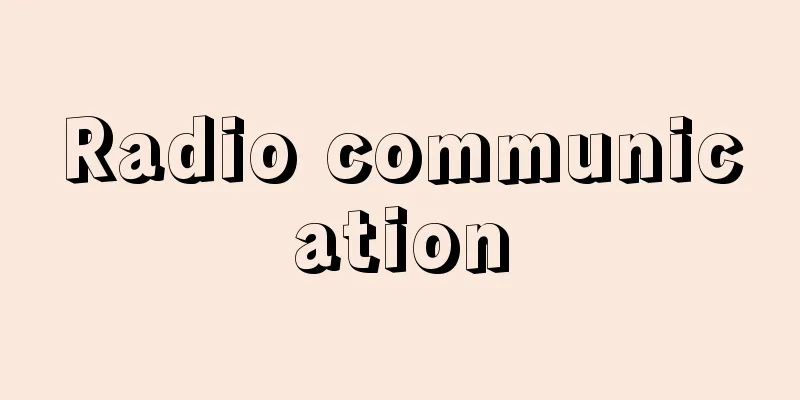Radio communication

|
A general term for communication using radio waves. The first person to successfully use radio waves for communication was G. Marconi of Italy in 1896. Marconi suspended a 100-meter copper wire high in the air with one end buried underground, marking the beginning of the antenna. Since then, with the development of electronics, such as vacuum tubes, transistors, and modern LSIs (large-scale integrated circuits), wireless communication has developed rapidly and is now used in all fields. Radio waves used for wireless communication include very long waves, long waves, medium waves, short waves, very short waves, extremely short waves, microwaves, and millimeter waves. In addition, wireless communication can be broadly classified into three categories based on its use: (1) fixed communication, (2) mobile communication, and (3) satellite communication. (1) Fixed-line communications: Communications between fixed points, mainly using microwaves. Until the 1990s, the 4 GHz, 5 GHz, and 6 GHz bands were widely used for long-distance communications on the telephone network, but these fixed-line communications have been replaced by optical communications, and the vacant frequency bands have been reorganized to be used for mobile communications, which are experiencing a rapid increase in demand. For medium- and short-distance communications, the 11 GHz and 15 GHz bands are mainly used, and the 20 GHz band is mainly used for short-distance communications. (2) Mobile communications: Communication in which either the sender or the receiver, or both, are moving. It has a long history, beginning with important communications such as ship communications, aircraft communications, and police patrol communications. In recent years, since the 1980s, it has spread to train phones, car phones, and now mobile phones as public communications. Due to the propagation characteristics of radio waves, the frequency bands used in mobile communications are short waves for long distance communications, and very high frequency waves and ultra high frequency waves for medium distances up to several tens of kilometers. In addition, ultra high frequency bands of 800 MHz and 1.5 GHz have been used for mobile phones, but in the future even higher frequency bands will be used. (3) Satellite communications: Communication via space stations such as artificial satellites in outer space. It has developed rapidly due to advances in geostationary satellite launch technology and the growing demand for international communications. Satellite communications can cover a wide area with a single satellite, so it is used not only for international communications, but also for communications with remote islands and during disasters. It is also used for domestic fixed communications and mobile communications. The frequency bands that are suitable for use are between 1 and 10 GHz, known as the "radio wave window," but frequency bands above 10 GHz (11, 14, 20, and 30 GHz) are also used due to the need to increase transmission capacity. [Ryo Tsuboi and Tetsuya Miki] [References] | | | | | | |Source: Shogakukan Encyclopedia Nipponica About Encyclopedia Nipponica Information | Legend |
|
電波を用いた通信の総称。電波を初めて通信に利用して成功したのはイタリアのG・マルコーニであり、1896年のことであった。マルコーニは、100メートルの銅線を空中高く懸垂し一端を地中に埋めたが、これがアンテナの始まりである。その後、真空管、トランジスタ、そして現代のLSI(大規模集積回路)に至るエレクトロニクスの進展により、無線通信は急速に発展し、現在ではあらゆる分野で使用されている。無線通信に用いる電波には、超長波、長波、中波、短波、超短波、極超短波、マイクロ波、ミリ波がある。 また、無線通信を用途面から分類すると、(1)固定通信、(2)移動体通信、(3)衛星通信の三つに大別できる。 (1)固定通信 固定した地点間の通信であり、マイクロ波を用いた方式が主流となっている。1990年代までは、電話網の長距離通信用として4ギガヘルツ帯、5ギガヘルツ帯、6ギガヘルツ帯が多く使用されていたが、これらの固定通信は光通信にとってかわられて、あいた周波数帯は再編成されて急速に需要を増している移動体通信などに使われることになっている。中・短距離通信方式では、11ギガヘルツ帯、15ギガヘルツ帯が主として使用され、20ギガヘルツ帯はおもに短距離用に用いられている。 (2)移動体通信 発信・受信のいずれか、あるいは双方が移動しながら通信するもの。船舶通信、航空機通信、警察のパトロール通信などの重要通信用から始まり、長い歴史がある。近年は1980年代から公衆通信用として列車電話、自動車電話、さらに現在の携帯電話へと普及してきた。移動体通信に使用される周波数帯は、電波の伝搬特性上、長距離通信は短波が、数十キロメートルまでの中距離は超短波、極超短波が使われている。また携帯電話は、極超短波の800メガヘルツ帯や1.5ギガヘルツ帯が使われてきているが、今後はさらに高い周波数帯が使われていくことになる。 (3)衛星通信 宇宙空間にある人工衛星などの宇宙局を介して行う通信で、静止衛星打上げ技術の進展と国際通信需要の増大によって、急速に発展した。衛星通信は、一つの衛星で広範囲をカバーできるので、国際通信のほか、離島との通信や災害時の通信などにも利用される。国内固定通信や、移動体通信にも用いられる。使用される周波数帯としては、「電波の窓」とよばれている1~10ギガヘルツの間が適しているが、伝送容量の増大の必要から、10ギガヘルツ以上の周波数帯(11、14、20、30ギガヘルツ帯)も使用されている。 [坪井 了・三木哲也] [参照項目] | | | | | | |出典 小学館 日本大百科全書(ニッポニカ)日本大百科全書(ニッポニカ)について 情報 | 凡例 |
<<: Radio-robot telemeteorograph
>>: Wireless power transmission - Musen Soden (English)
Recommend
Sheep botfly (sheep fly)
An insect of the Diptera family, Ophididae. The la...
Light and Dark
A full-length novel by Natsume Soseki. It was ser...
Kidnapping - kidnapping
The crime of kidnapping a minor or an adult for th...
Bhaṭṭi (English spelling) Bhatti
...In the world of lyric poetry, the most famous ...
Gora Belukha (mountain)
It is a high mountain in the eastern part of the K...
Cork tissue
… In Japan, all of the amount used is imported fr...
Sei Shonagon
His birth and death years are unknown. He was a p...
Hippocrates
An ancient Greek physician. Born on the island of ...
Missing character - missing character
When the name of an emperor or noble person appear...
Anovulatory menstruation - anovulatory menstruation
Menstruation without ovulation. Because ovulation ...
Kanzashidai - Kanzashidai
…The Japanese and English names are derived from ...
Caro, A. (English spelling) CaroA
...In the narrow sense, it refers to the above ex...
Amakasu Incident
On September 16, 1923 (Taisho 12), the military p...
Hirata [village] - Hirata
A village in Ishikawa County, southeastern Fukushi...
Schuster, T.
…He was born in Cologne as the son of a legal adv...









